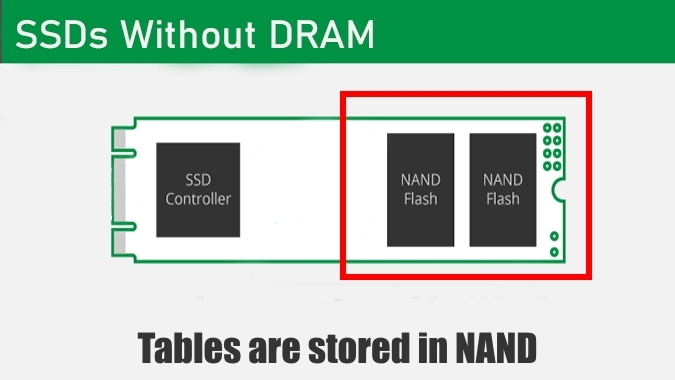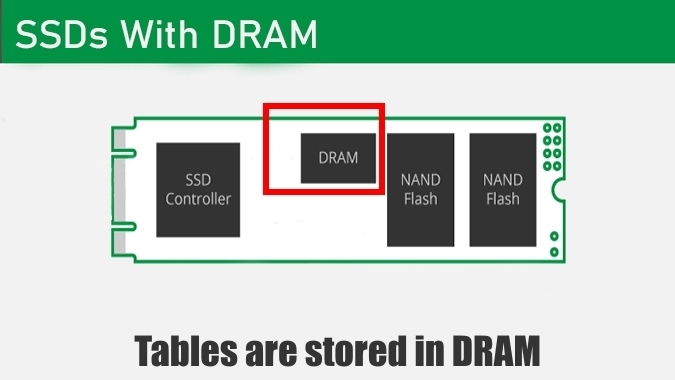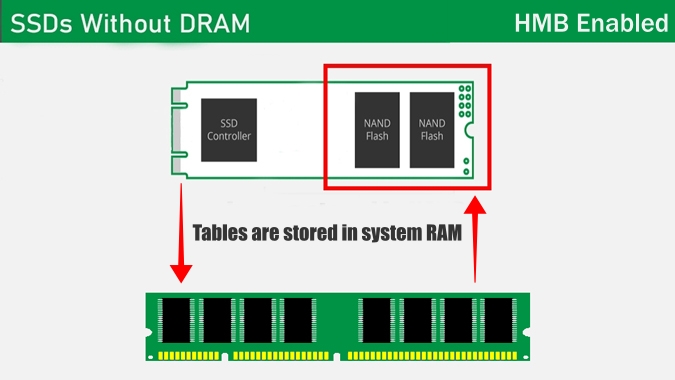Faster OS boot times, quick app launches, lightning-fast transfer speeds, and no whirs and clicks. Yes, SSDs were a much-needed upgrade for the average user. However, all SSDs are not equal. An SSD with DRAM in it for eg. is technically better than one without it. So what is DRAM in an SSD? Why is better to have it in your SSDs? How can you identify SSDs with DRAM? This guide aims to get you up to speed with everything about SSDs with and without DRAM and how to tell them apart.
Table of Contents
What Is DRAM in an SSD
SSDs, as you may already know, don’t have any moving parts. They store data into something called the NAND flash. SSD contains one or more NAND flash chips into which data is written and rewritten as per CPU’s instruction. SSDs also use something called Data map tables to track where the data is saved in NAND to read, move, or rewrite them as needed.
DRAM-less SSDs store these tables in the NAND itself. However, if an SSD has DRAM in it, it stores these tables in DRAM leading to better data management, faster speeds, and longevity. The existence of DRAM is not exclusive to any SSD form factor. All form factors like 2.5 inch, M.2, and even NVME SSDs have models that may or may not have DRAM in them.


Advantages of SSDs With DRAM
Let us discuss some pros of SSDs that have DRAM within.
Speed
SSDs with DRAM is considerably quicker than DRAM-less SSDs in virtually every metric. The presence of a DRAM chip means that the CPU does not need to access the slower NAND chips for mapping tables while fetching data. DRAM being faster provides the location of stored data quickly for viewing or modification. This leads to better random read and writes speeds. Common tasks like web browsing and background operating system tasks rely heavily on random read and write speeds. SSDs without DRAM can also cause stutter more often due to a delay in looking up data map tables.
Longevity
The lack of DRAM also puts significant wear and tear on NAND chips being constantly used for data map lookups. DRAM-less SSDs, therefore, have lower life spans than SSDS with DRAM. Manufacturers also provide shorter warranty periods for DRAM-less SSDS due to the probability of them dying sooner.
Applications of DRAM-Less SSDs
In which situations or scenarios would you need an SSD without DRAM? Only one, it seems.
Cheap
DRAM-less SSDs are cheaper compared to their DRAM-endowed counterparts. While being slow, they are still faster than the fastest mechanical hard drive you can find on Earth. They would still easily boost your PC speeds when upgraded from a hard drive. There is also a seasonal lack of availability for SSDs with DRAM. Due to shortages in production and availability of DRAM chips, DRAM-less variants are generally more readily available for purchase.
What About HMB-Enabled DRAM-Less SSDS
Newer DRAM-less SSDs come with something called HMB which stands for Host Memory Buffer and borrows system memory to do the task of a DRAM chip. HMB-enabled, DRAM-less SSDs are definitely faster than ordinary DRAM-less SSDs. However, they are still not on par with SSDs with a dedicated DRAM chip in terms of speed. The use of system RAM could also lead to less available memory for traditional tasks that could cause slowdowns. SSDs with DRAM is, therefore, still better than any variant of DRAM-less SSDs.

Identifying SSDs With DRAM From DRAM-Less SSDs
Identifying if an SSD has DRAM or not is a difficult task. Most manufacturers do not outright mention if a particular model has DRAM or not. Sadly, no software can detect the presence of DRAM Cache either, not at the time of writing this article anyway.
However, there exists curated lists on the internet that keeps databases about all the specifications of most SSDs ever released. This also includes information about whether a DRAM chip is built into the system or not.
Johnylucky.org is one such database that keeps a vast record of information about SSDS that have been released. The website also constantly updates the database for newer product launches.
Another such database is this constantly updated spreadsheet made by NewMaxx which also confirms whether the SSD has DRAM or not.
Finally, if you know how to open an SSD safely, you can open the SSD to check if it has a DRAM chip onboard. However, this could potentially damage your SSD so do it only if you know what you are doing.
What’s Inside Your SSD
SSDs are not as simple as one would think. The existence of DRAM in an SSD, for instance, can make or break it for many users. We wish that SSD manufacturers were more direct about such things and list it on the box somewhere. Savvy users would appreciate such things. On other things related to data drives, here’s how to identify between SMR and CMR Hard drives.